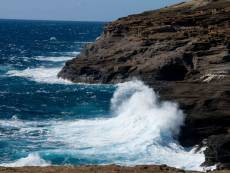

Erosion of a headland
A headland is an area of hard rock which sticks out into the sea. Headlands form in areas of alternating hard and soft rock. Where the soft rock erodes bays are formed either side of the headland. As the headland becomes more exposed to the wind and waves the rate of its erosion increases. When headlands erode they create distinct features such as caves, arches, stacks and stumps.
Longshore drift (transportation)
Waves approach the beach at an angle a similar direction to that of prevailing wind.
Swash carries material up the beach. In the same direction as prevailing wind
Backwash carries material directly down from the beach under gravity
The process continues along the beach carrying material in a zig zag course. Features created from this process include spits, bars and tombolas.
Spit (depositional feature)
A spit is a long narrow accumulation of sand or shingle, with the end attached to the land and the other projecting in the sea or river.
Spits form when longshore drift moves large amounts of sand/ shingle along the coast and where the coast suddenly changes direction to leave a shallow, sheltered area of water
Hard and soft rock coastlines
Hard
Sea walls
often built in front of seaside resorts
Very expensive
They aim to completely block the waves and their effects
Life span of approximately 75 years
Can cause the erosion of the beach in front of them
Socially reassuring for local residents
Soft
sand is either brought in from elsewhere, or transported back along a beach, usually once a year
This is done using trucks, and is therefore very costly and time consuming
Over the next 12 months the material is washed along the coast by longshore drift, before being replaced again. The final method of coastal management is of course is to do nothing and allow the sea attack the coastline naturally.
Coastal management
Hard engineering
Cliff drainage/ drainage pipes
Pipes laid through the cliff to the beach
Advantage- reduces the amount of rainwater stored in the cliff helps to reduce slumping
Disadvantage- if successful can result in the subsidence of cliff top land as the cliff dries out.
Sea wall
Usually concrete walls built at the base of the cliff.
Advantage- effective against erosion and flooding promenade for tourists
Disadvantages- expensive, about £7000 per metre. It needs maintenance about every 30 years. Ugly, it spoils the view of the coast.
Remnants (timber or concrete)
Timber or concrete pasts driven into the beach with connecting timber. The aim is to dissipate waste energy.
Advantages- relatively cheap, about £2000 per metre. Permeable so allows sediment to pass through and a beach to build up at the base of the cliff
Disadvantage- timber will rot and need replacing, needs to be maintained, foundations can be undermined
https://www.nationalgeographic.org/encyclopedia/coast/

0 Comment:
Be the first one to comment on this article.